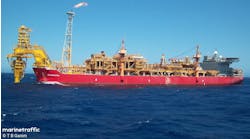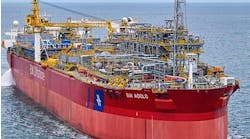Combine will offer comprehensive range of thrusters for oil industry use
Halliburton's liftboat Irish Sea Pioneer.
Azimuth thruster and deck machinery specialist Aquamaster-Rauma will remain a force behind oil and gas supply vessels following its recent acquisition by marine propulsion group KaMeWa.
The combined entity will have a turnover of over SKr1,200 million. According to KaMeWa's managing director Ingar Jensen, it will offer "a full range of propulsion products including a wide variety of thruster types".
KaMeWa is currently supplying thrusters for the new generation of North Sea floating production ships. Aquamaster-Rauma (AR) designed and built the world's largest azimuthing propulsion units for its former owner Finnyards for the offshore support/icebreaker vessels Fennic and Nordica.
In recent times AR has been developing new concept vessels for the oil industry, including safety tankers and escort tugs. But now the company will also have access to KaMeWa's "world renowned" research laboratories, according to AR managing director Timo Salokoski.
CRP Z-drive
Naval architects Delta-Marin of Turku performed the feasibility study for the new Aquamaster safety tanker concept. AR is promoting its new contra rotating propeller (CRP) Z-drive unit for 15-40,000 dwt product carriers with 6-9MW of propulsion power. The concept is claimed to offer a high level of safety and redundancy both in propulsion and steering; flexibility in draught and operation; and an operational flexibility equal to, or better than, diesel-electric vessels.
But two CRP 25 thrusters will also be installed in a diesel-electric ship: a new 84-metre long, 4,100 dwt platform supply vessel being built by Bratvaag Shipyard for Remoy Management in Norway. This will be the world's first supply vessel to use CRP thrusters.
Advantages of installing a diesel-electric azimuth propulsion system are said to lie in the free location of the engine. Power can be shared between the onboard consumers, while at the same time using the diesel engines' capacity effectively and economically. The combination of the contra-rotating propellers and the azimuth unit should also make the vessel highly maneuverable.
AR is also providing one UL901 propulsion unit to the bow of the vessel to provide extra maneuvering precision in DP mode and to fulfill the DYNES AUT EPR notation.
Irish Sea
Four Aquamaster US 1401 drives will provide propulsion and maneuvering capability for another new support vessel, Halliburton's Irish Sea Pioneer. This is a "liftboat"- a self-propelled, self-elevating vessel intended for rapid in-field transit between production platforms.
The 56-metre long, 4,064 mt displacement vessel, designed by Bollinger Machine Shop and Shipyards, Louisiana, has been commissioned for Hamilton's new Liverpool Bay multi-field development off northwest England. Tight maneuvering around platforms is necessary to maintain position and heading while the liftboat's 250-ft long legs are lowered to or raised from the sea floor.
For safety purposes Irish Sea Pioneer is designed to move away from a platform with any of its three thrusters operational. Its control system hierarchy steps from integrated, single joystick controls to tandem operation of the thruster bow pair and stern pair, to individual thruster full follow-up, to non follow-up operation.
In Taiwanese waters, the first of a new class of 3,800HP Aquamaster tugs has been operating since May 1994. No 3 Tao-Yu is a 33 metre long Special Oil Recovery Tug (Sort 33) built by Lien Ho Shipyards for the China Petroleum Corporation of Taiwan.
The tug, designed by Marco, Seattle, is normally used for towing, ship-handling and firefighting, but in the event of an oil spill it can be converted in minutes to a self-sufficient oil recovery vessel, capable of salvaging around 100 tons of diesel or 400 tons of crude per hour.
Two Aquamaster US 1401 azimuth thrusters driven by two 1,380 kW diesel engines control maneuvers in ship-assist mode. And because of their modular design, these units can be easily removed for service without the need for dry-docking.
Copyright 1995 Offshore. All Rights Reserved.




